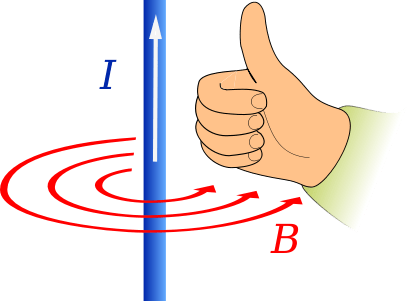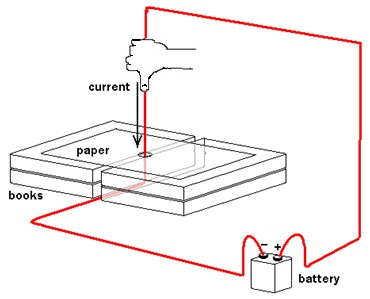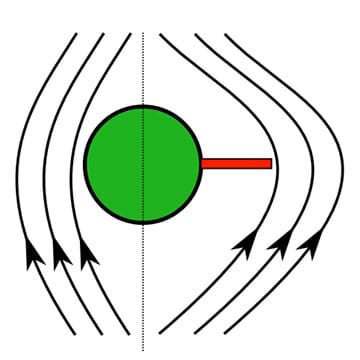Quick Look
Grade Level: 9 (9-11)
Time Required: 45 minutes
Expendable Cost/Group: US $7.00
Group Size: 3
Activity Dependency:
Subject Areas: Science and Technology
NGSS Performance Expectations:

| HS-PS2-5 |

Summary
Students use the same method as in the activity from lesson 2 of this unit to explore the magnetism due to electric current instead of a permanent magnet. They use a compass and circuit to trace the magnetic field lines induced by the electric current moving through the wire. Students develop an understanding of the effect of the electrical current on the compass needle through the induced magnetic field and understand the complexity of a three-dimensional field system.Engineering Connection
Electromagnetic induction is a fundamental principle underlying motor design and many disciplines of both electrical and mechanical engineering. The study of electromagnetic fields is also a fundamental discipline of electrical engineering. Students think about how they might use an electromagnet as engineers to design a device to separate steel from aluminum for a recycler.
Learning Objectives
After this activity, students should be able to:
- Describe the shape of the induced magnetic field of an electrical current.
- Describe how current in a particular direction yields a curving magnetic field according to the right hand rule.
Educational Standards
Each TeachEngineering lesson or activity is correlated to one or more K-12 science,
technology, engineering or math (STEM) educational standards.
All 100,000+ K-12 STEM standards covered in TeachEngineering are collected, maintained and packaged by the Achievement Standards Network (ASN),
a project of D2L (www.achievementstandards.org).
In the ASN, standards are hierarchically structured: first by source; e.g., by state; within source by type; e.g., science or mathematics;
within type by subtype, then by grade, etc.
Each TeachEngineering lesson or activity is correlated to one or more K-12 science, technology, engineering or math (STEM) educational standards.
All 100,000+ K-12 STEM standards covered in TeachEngineering are collected, maintained and packaged by the Achievement Standards Network (ASN), a project of D2L (www.achievementstandards.org).
In the ASN, standards are hierarchically structured: first by source; e.g., by state; within source by type; e.g., science or mathematics; within type by subtype, then by grade, etc.
NGSS: Next Generation Science Standards - Science
| NGSS Performance Expectation | ||
|---|---|---|
|
HS-PS2-5. Plan and conduct an investigation to provide evidence that an electric current can produce a magnetic field and that a changing magnetic field can produce an electric current. (Grades 9 - 12) Do you agree with this alignment? |
||
| Click to view other curriculum aligned to this Performance Expectation | ||
| This activity focuses on the following Three Dimensional Learning aspects of NGSS: | ||
| Science & Engineering Practices | Disciplinary Core Ideas | Crosscutting Concepts |
| Plan and conduct an investigation individually and collaboratively to produce data to serve as the basis for evidence, and in the design: decide on types, how much, and accuracy of data needed to produce reliable measurements and consider limitations on the precision of the data (e.g., number of trials, cost, risk, time), and refine the design accordingly. Alignment agreement: | Forces at a distance are explained by fields (gravitational, electric, and magnetic) permeating space that can transfer energy through space. Magnets or electric currents cause magnetic fields; electric charges or changing magnetic fields cause electric fields. Alignment agreement: …and "electrical energy" may mean energy stored in a battery or energy transmitted by electric currents.Alignment agreement: | Empirical evidence is required to differentiate between cause and correlation and make claims about specific causes and effects. Alignment agreement: |
International Technology and Engineering Educators Association - Technology
-
Students will develop an understanding of the relationships among technologies and the connections between technology and other fields of study.
(Grades
K -
12)
More Details
Do you agree with this alignment?
State Standards
Tennessee - Science
-
Understand magnetic poles, magnetic fields, and investigate electromagnetic induction.
(Grades
9 -
12)
More Details
Do you agree with this alignment?
-
Probe the fundamental principles and applications of electricity.
(Grades
9 -
12)
More Details
Do you agree with this alignment?
Materials List
Each group needs:
- 1 6-V Zn-C battery (US $1.30)
- 1 compass (diameter 16 mm; US $1)
- 1 75-cm length wire
- 1 6.2 V, 0.5 A incandescent light bulb (US $1.30)
- 1 light bulb receptacle (US $1.98)
- 4 textbooks
- Induced Magnetic Field Worksheet
Worksheets and Attachments
Visit [www.teachengineering.org/activities/view/van_cleanupmess_act3] to print or download.Pre-Req Knowledge
An understanding of the movement of charge in an electrical circuit and of the effect of different electrical properties on current strength.
Introduction/Motivation
In the previous activity, you detected and drew the magnetic field of a permanent magnet. What important tool did you use? (Make sure students identify the compass.)
Now, you will find the magnetic field around an electric current. To produce the electric current, you will need a battery, wire and light bulb. Hook up your circuit, and find the magnetic field with your compass following the procedures I will describe next.
Procedure
Setup
- Make copies of the Induced Magnetic Field Worksheet, one per group.
- Have ready the required materials for each group.
- Divide the class into groups of three students each.
- Present the Introduction/Motivation section.
- Hand out the worksheets and direct students to mark 30 points spread out across the paper.
- Provide students with the activity materials and let them to investigate on their own.
- After students have identified that there is no magnetic field detected in the same plane as the current, inform them that the magnetic field is actually in a different dimension, so the setup needs to have the current going somewhere else besides on along the table top, then walk them through the setup as shown in Figure 1.
- Have students diagram the magnetic field by putting the compass at different points on the paper and drawing an arrow to show the direction of the compass needle until all points have been catalogued.

Figure 1. Induced magnetic field detection setup.
Assessment
Upon completion of the field diagrams, have several groups draw their diagrams on the classroom board for comparing and contrasting. Point out the circular pattern of the arrows and inform students of the right-hand rule using the drawing provided at the top of this document.
If time permits, have students reverse the terminal connections, causing the current to flow up through the paper rather than down. Have them observe the change in the magnetic field and verify the right-hand rule.
Investigating Questions
- Can you turn the magnets you are measuring on and off? How would you do that? (Answer: By turning the current on and off.)
- What happens if you reverse the connections on the battery?
Troubleshooting Tips
The light bulb and holder are provided so the students have evidence that current is flowing through the wire and to keep the wire from growing too hot. Its resistance, however, may slow the current enough that it cannot produce a strong enough magnetic field for the compass to detect. During step 4, it is okay if students use the light bulb in the circuit, but once the setup shown in figure 1 is built in step 5, it is best to leave the light bulb out (to achieve a strong enough current) and only have students connect the wire briefly when they are directly observing the compass. Be careful as the wire will get hot.
During step 4, students will likely have both the compass and the wire laid flat on the table. Because the compass cannot turn in the direction of the field, which is into and out of the table, they should see no effect of the current on the magnetic field. If they insist they have observed an effect, have them turn the current on and off by disconnecting the wire from the battery. If there were a magnetic field due to the current, disconnecting the wire would cause a movement of the compass needle, but there will be no movement. Any magnetic field observed will be due to the earth's magnetic field; all compass needles should point north at this point unless students lift the wire off the table so it is not flat anymore.
During step 5, it is important that students maintain a consistent direction of current in all groups. It is important that end of the wire held vertically be the end connected to the positive terminal and that the end going through the paper and between the books be connected to the negative terminal. Otherwise, students will observe the reverse field direction from the other groups.
When students are measuring the magnetic field, it is possible that the end of the field pointing south does not register a significant movement in the compass. Teachers will have to explain to students that the field is in fact pointing the opposite way of the needle but the needle does not rotate because the field is cancelled by the earth's magnetic field.
Subscribe
Get the inside scoop on all things TeachEngineering such as new site features, curriculum updates, video releases, and more by signing up for our newsletter!More Curriculum Like This

Students induce EMF in a coil of wire using magnetic fields. Students review the cross product with respect to magnetic force and introduce magnetic flux, Faraday's law of Induction, Lenz's law, eddy currents, motional EMF and Induced EMF.

Students learn more about magnetism, and how magnetism and electricity are related in electromagnets. They learn the fundamentals about how simple electric motors and electromagnets work. Students also learn about hybrid gasoline-electric cars and their advantages over conventional gasoline-only-pow...

Students complete the grand challenge of this unit and design an electromagnet to separate steel from aluminum for a recycler. In order to do this, they compare the induced magnetic field of an electric current with the magnetic field of a permanent magnet and then make the former look like the latt...

Students learn about nondestructive testing, the use of the finite element method (systems of equations) and real-world impacts, and then conduct mini-activities to apply Maxwell’s equations, generate currents, create magnetic fields and solve a system of equations. They see the value of NDE and FEM...
Copyright
© 2013 by Regents of the University of Colorado; original © 2011 Vanderbilt UniversityContributors
Justin Montenegro, Glencliff High School, NashvilleSupporting Program
VU Bioengineering RET Program, School of Engineering, Vanderbilt UniversityAcknowledgements
The contents of this digital library curriculum were developed under National Science Foundation RET grant nos. 0338092 and 0742871. However, these contents do not necessarily represent the policies of the NSF, and you should not assume endorsement by the federal government.
Last modified: May 22, 2019









User Comments & Tips